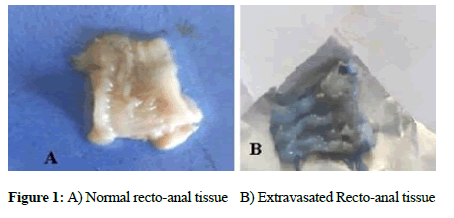Research Article: Journal of Drug and Alcohol Research (2022) Volume 11, Issue 7
Ethanolic Leaf Extract of Moringa Oleifera A Potential Agent For Treatment Of Hemorrhoids: And Its Evaluation in Croton Oil Induced Hemorrhoidal Rats
Sai Krishna Nallajerla* and Suhasin GantaSai Krishna Nallajerla, Department of Pharmacology, GITAM Institute of Pharmacy, GITAM (Deemed to be University), Visakhapatnam, A.P, India, Email: Nallajerla@yahoo.co.in
Received: 04-Jul-2022, Manuscript No. jdar-22-70695; Editor assigned: 06-Jul-2022, Pre QC No. jdar- 22-70695(PQ); Reviewed: 20-Jul-2022, QC No. jdar-22-70695; Revised: 25-Jul-2022, Manuscript No. jdar-22- 70695 (R); Published: 01-Aug-2022, DOI: 10.4303/jdar/236189
Abstract
Hemorrhoids are gastro intestinal disorders associated with engorged venous cushions in the anal canal. Protrusion of anal cushions, rectal bleeding, irritation, and mucus discharge from the anus are the major symptoms of the disease. Inflammation remains to be one of the pathogenic mechanisms for the development of disease. Hence, in the present study, the ethanolic leaf extract of Moringa oleifera (ELEMO) in two different doses, 200 mg/kg/ir and 400 mg/kg/ir, was evaluated for its anti-inflammatory mediated anti-hemorrhoidal effect in croton oil induced hemorrhoidal rats. The study results revealed that intra rectal application of croton oil preparation in albino rats induces hemorrhoids by the elevation of serum pro-inflammatory cytokines, TNF-α, and IL-6 in group-II positive control animals. Whereas, ELEMO treatment in group IV and V animals revealed a dose dependent reduction of serum TNF-α and IL-6 along, with a significant reduction of EB dye extravasation in this group animals. Plant extract in the research was also showed a significant effect on Recto anal coefficient of experimental rats. Further, histopathological studies carried out on recto anal tissues of experimental animals revealed protective nature of ELEMO on hemorrhoid markers.
Keywords
Moringa oleifera; Evans blue; Croton oil; Hemorrhoids; TNF α; IL-6
Introduction
Hemorrhoids, also known as piles, are a common anorectal condition [1]. This lower gastro intestinal disorder was linked to symptoms such as bleeding during defecation, dilation and protrusion of rectal blood vessels, pain, and burning sensation in the anus [2]. The prevalence of the disease was found to be high and most affected group are Caucasians. Both men and women, at some stages of their lives are affected, with peak incidence reported from the ages of 45-65 years [3]. The disease affects nearly 40% of adults. It can cause great discomfort, disability and a decrease in the quality of their life [4]. This socioeconomic disease develops due to potential risk factors like sedentary life style, overweight, constipation, pregnancy, and older age, etc [5]. Based on the degree of prolapse and dentate line, they are classified into internal hemorrhoids present above the dentate line of anus, external hemorrhoids present below the dentate, and mixed hemorrhoids present above or below the dentate line [6]. Further, Goligher has given classification for internal hemorrhoids [7]. He classified internal hemorrhoids based on the degree of prolapse as First-degree hemorrhoids: where anal cushions bleed but do not protrude. Second degree hemorrhoids where anal cushions prolapse and reduce spontaneously into the anus. Third-degree hemorrhoids in which anal cushions protrude and need manual replacement into the anal canal. Fourth-degree hemorrhoids remain prolapse all the time and irreducible. Hemorrhoids can be treated by using various methods like dietary life style changes, topical applications, oral medications, non-surgical, and surgical procedures [7]. Most of these procedures suffer with the disadvantages like, high cost, recurrence, headache with topical applications, rectal bleeding, mucus discharge along with ulcer, post operative pain, and infection after surgical procedures. Therefore, the treatment options in modern medicine are found to be poor [8]. Hence, the authors look for traditional plants as a major source for development of novel drugs. So, in the present study, Moringa oleifera reported with valuable phytoconstituents belongs to the family Moringaceae has chosen [9]. Its, anti-inflammatory mediated anti-hemorrhoidal potential was evaluated in croton oil induced hemorrhoidal rats.
Materials and Methods
Drugs and chemicals
For the present study the following chemical were used. 6% croton oil was obtained from neighbouring Pharmacy College, 99.5% ethanol, and diethyl ether was obtained from chemical store of AKRG Pharmacy College. Croton oil 6%, 99.5% ethanol, pyridine, and diethyl ether were used in the study. They were taken from AKRG Pharmacy College. Evans blue (EB) dye is used for measurement of croton oil induced extravasation is procured from supplier, greater scientific products, Vijayawada. Enzyme kits TNF-α (cat no. KB2188) and IL-6 (cat no. KB0451) were gifted by Jogaih institute of pharmacy, Reference drug pilex ointment was used from the study is obtained from retail pharmacy. All the other chemicals taken for the present study were analytical grade. They are gathered from a local supplier, NSP.
Animals
The present study was carried out on albino rats of either sex weighing 160-170 grams. All the study animals are allocated randomly into various groups. They were maintained under standard conditions and are provided with a standard pellet diet and water. The proposed study was carried out by following the animal ethical guide lines CPCSEA. The experimental protocol no: AKRGCP/IAEC/2018-1 was approved by Institutional Animal Ethics committee (IAEC) of AKRG College of Pharmacy 1373/PO/Re/s/10/cpcsea.
Preparation of ethanolic leaf extract of Moringa oleifera (ELEMO)
Ethanolic leaf extract was prepared by collecting fresh leaves early in the morning. The leaves were left in the shade to dry and powdered. Leaves are extracted by using ethanol 99.9% for 250 grams of plant powder in a soxhlet chamber. The temperature in a soxhlet chamber was kept constant at 78°C. The obtained fraction was carried for drying and evaporated using a rotary evaporator and the percentage yield was calculated [10].
Preliminary Phytochemical Screening
By following the procedures reported by Junaid Sheik [11]. Qualitative analysis was carried out on Moringa oleifera ethanolic leaf extract. Test results showed the presence of several phytochemicals in plant extract like alkaloids, tannins, flavonoids, proteins, phenolic groups, and glycosides etc.
Experimental design
Experimental design contains evaluation of anti-inflammatory mediated anti-hemorrhoidal activity of ELEMO by three phases:
Phase-I: In-vitro testing
Phase-II: In-vivo testing
Phase-III: Histopathological studies.
In-vitro Anti-inflammatory activity of ElEMO
The development of hemorrhoids was multifactorial both inflammation and edema found to intensify the disease [12,13]. Hence, this part of study contains initial in-vitro study carried out, on the ELEMO to evaluate the beneficial role of plant extract on inflammation. In-vitro study was carried out by measuring the egg albumin protein denaturation inhibitory property of ethanolic leaf extract. Diclofenac sodium was taken as a standard drug for the present study. Different concentrations of 100 μg/ml, 200 μg/ml, 400 μg/ml, and 600 μg/ml of volume 5 ml were prepared for both diclofenac sodium and ethanolic leaf extract by serial dilutions. Then a reaction mixture was prepared for each concentration of plant extract by adding 2.8 ml of saline phosphate buffer (pH 6.4), 0.2 ml of egg albumin and 2 ml of plant extract dilution. A similar reaction mixture was also prepared for each concentration of the standard drug diclofenac sodium. Distilled water taken in the study acts as a positive control. The prepared reaction mixtures were incubated in a water bath at 37°C ± 2°C for 15-20 min. Following incubation period the mixtures was heated at 70°C for 5 min. Later incubation period they were cooled at room temperature for 15 min. Then the absorbency of a reaction mixture was identified three times by using calorimeter for each dilution. From this the mean absorbency is calculated. The values are then incorporated into the following formula to calculate percentage inhibition of protein (egg albumin) denaturation by plant extract was calculated by applying the following formula [14].
Evaluation of Anti-hemorrhoidal activity of ELEMO in croton oil induced hemorrhoidal rats by extravasation technique
This section of the study includes in-vivo evaluation of anti-inflammatory mediated anti-hemorrhoidal property of ELEMO. Ethanolic leaf extract was evaluated both in low dose 200 mg/kg/ir and high dose 400 mg/kg/ir against croton oil induced hemorrhoidal rats. Pilex ointment (PO) was chosen as a standard for the study. The study was carried out by following the method done by Mohammed Azeemuddin et al. with minor modifications [15]. The duration of the study period is five days, and procedure was carried on the first set of randomly selected animals containing 30 albino rats. They were grouped randomly into five groups n=6. Hemorrhoids are developed in albino rats by intra rectal application of croton oil preparation. By this method, linear development of oedema can be induced by croton oil preparation from the first 7-8 hours [16]. Croton oil preparation contains 6% of croton oil, de ionised water, pyridine, diethyl ether in the ratio of 1:4:5:10 [17]. This method consists of application of EB dye extravsation technique to measure inflammatory proteins. At the end of the study, blood samples were collected through retro orbital puncture from study animals. Serum was separated and analysed for proinflammatory cytokines TNF-α, IL-6, and blood percentage of neutrophils count were estimated. The Recto anal coefficient (RAC), of research animals was determined to observe the effect of plant extract on croton oil induced rectal inflammation. The study also contains evaluation of the daily average stool weight of study animals to observe any effect of plant extract over constipation, a hemorrhoid marker.
Induction of Hemorrhoids in experimental animals
Hemorrhoids are developed in all groups of rats except in group I animals, by using sterile cotton swab previously soaked for 10 seconds in croton oil preparation. Soaked cotton swab was inserted up to 20 mm into the anorectal region of study animals for 10 seconds [18]. 24 hours after the induction of hemorrhoids, all the groups of animals are assigned to the following treatment.
Group I: Treated with normal saline act as a normal control.
Group II: Treated with normal saline act as a positive control.
Group III: Treated with pilex ointment (PO) 200 mg/kg/ ir/per rat.
Group IV: Treated with received low dose of ELEMO 200 mg/kg/ir/per rat.
Group V: Treated with high dose of ELEMO 400 mg/kg/ ir/per rat.
Dilution of Evans blue dye for introduction into tail vein
Croton oil, in study animals known to induce hemorrhoids by development of vasodilation, oedema, and inflammatory proteins [18]. In order to quantify these inflammatory proteins the researchers has used extravasation technique. To achieve this EB dye 30 mg/kg of body weight was diluted in deionised water and injected through the tail vein of experimental rats just before 30 minutes of administration of croton oil preparation.
Extraction of EB dye from recto-anal tissue
At the last day, of the research, after administration of the respective treatment to the albino rats, they are sacrificed. Recto anal tissue measuring 20 mm long from the anal opening is collected. They were placed in aluminium foil in oven. Temperature in the oven was set to 56áµ?C and maintained for two days to dry. After two days the tissue was taken out of the oven EB dye, was extracted from anal tissue by mixing 8 ml of formamide per gram of tissue. This was depicted in Figure 1. Later the tissue was again kept in the oven at 56°C for two days to dry. After two days in the oven, formamide, which turns into blue in colour, was collected by using a pipette and the remaining tissue was discarded. The absorbance of the fluid is recorded at 625 nm by using a spectrophotometer. EB dye concentration in the study indicates the inflammatory mediators or oedema. Hence, the concentration of EB dye from the absorbency was calculated using standard curve of Evans blue dye. The standard curve was plotted by diluting the EB dye in formamide solution in exponential concentrations of 0;1;2;4;8;16;32;64 and 128 μg/ml [19].
Evaluation of Anti-hemorrhoidal activity of ELEMO against croton oil induced histological changes in rectal tissue of rats.
Figure 1: A) Normal recto-anal tissue B) Extravasated Recto-anal tissue
Histological studies were conducted on the rectal tissues of croton oil induced hemorrhoidal rats. This study helps in identifying croton oil induced inflammation mediated hemorrhoid markers in the rectal tissues of rats. It was carried out in the second set of animals comprising 30 albino rats. Albino rats are randomly selected and separated into five groups each group is allocated with 6 animals and they receive the following treatment for 5 days. Hemorrhoids are induced in albino rats by intra rectal application of cotton oil preparation. After induction of hemorrhoids the experimental animals are assigned to the following treatment. The Group I served as normal control received normal saline; Group II served as positive control normal treated with croton oil preparation intra rectally; Group III served as standard treated with pilex ointment 200 mg/kg/ir/per rat: Group IV served as test treated with ELEMO 200 mg/ kg/ir/per rat; Group V served as test treated with ELEMO 400 mg/kg/ir/per rat. All the experimental animals are sacrificed at the end of the study, and recto-anal tissues measuring length 20 mm long from the anal end are collected and preserved in 10% neutral buffered formalin. The tissues are then, submitted for histopathological examinations.
Statistical analysis
All the results of the research were expressed as mean ± SEM. Results obtained were analysed by one way ANOVA with Dunnett’s post hoc test with the help of Graph Pad Prism version 8 for Windows. Values are expressed as mean ± SEM #P<0.001 compared to normal control; **P<0.01 compared to positive control and ***P<0.001 compared to positive control.
Results and Discussion
Effect of ELEMO on percentage inhibition of protein denaturation
By using calorimeter in-vitro percentage inhibition of protein (egg albumin) denaturation activity of plant was determined. The reaction mixture prepared for various dilutions of ELEMO, diclofenac sodium and control were analysed. The obtained mean absorbency values are incorporated into the formula, percentage inhibition. Results obtained were found to be interesting ELEMO at various concentrations 100 μg (60.26 ± 3.49), 200 μg (62.86 ± 1.96,) 400 μg (72.86 ± 6.73), and 600 μg/ml (71.38 ± 2.91) offered inhibitory effect on egg albumin protein denaturation. A dependent type of effect is noticed where increase in response is obtained by rising the dose of M. Oleifera. On the other hand standard drug diclofenac sodium at similar concentrations 100 μg (57.77 ± 3.45), 200 μg (69.57 ± 1.87), 400 μg (77.97 ± 2.42), and 600 μg (83.39 ± 2.27) also observed to inhibit egg albumin protein denaturation as shown in Figure 2. After the interpretation, of the obtained results, it became evident that ethanolic leaf extract had an inhibitory effect on protein denaturation, which is a positive effect for reducing inflammatory mediators in hemorrhoids. From the obtained results, protein denaturation inhibitory concentration IC 50 was calculated by using GraphPad Prism 8. The IC 50 value for diclofenac sodium was found to be 57.68 μg/ml and IC 50 value for ELEMO was found to be 36.67 μg/ml as depicted in Figure 3. Effect of ELEMO on Extravasation of EB dye in croton oil induced hemorrhoidal rats. Development of hemorrhoids was found to be associated with inflammatory mediators TNF-α, and IL-6 [20]. Croton oil preparation in experimental animals found to induce rectal inflammation, was measured by using the extravasation technique. After sacrificing the animals on the last day of the study, extravasation of EB dye was clearly observed in rectal tissues of rats. Dye was extracted by using extraction procedure and the mean absorbency of EB dye was measured by using a double beam spectrophotometer. Concentration of EB dye is calculated using the standard graph of EB dye as depicted in Figure 4. The study results revealed the following observations: The concentration of EB dye is significantly raised in positive control group animals (30.44 ± 1.63) when compared to normal group animals, group I (2.47 ± 0.22). Pilex ointment (PO) 200 mg/kg/ir/per rat (10.97 ± 0.80) was found to offer a significant decrease in EB dye concentration in group III animals, when compared to positive control group animals. Further, in this research ELEMO in group IV and group V animals, treated with 200 mg/kg/ir (19.08 ± 1.65) and 400 mg/kg/ir (9.84 ± 0.59) of plant extract offered a significant reduction of croton oil preparation induced extravasation of EB dye in rats as depicted in Figure 5. The effect produced by ELEMO at 400 mg/kg was found to be better than standard group treated rats. Effect of ELEMO on blood percentage of neutrophils count in hemorrhoidal rats. Neutrophils from early reports are known as inflammatory mediators. Hence, the effect of ELEMO on blood percentage of neutrophils count was esteemed. On evaluation of blood samples of experimental rats, elevated levels of blood neutrophils count are noticed in positive control group rats (26.33 ± 1.26) compared to normal group rats (12.50 ± 0.50). Intra rectal, application of pilex ointment 200/kg/ir/rat offered a significant reduction in the blood percentage of neutrophils (19.17 ± 1.31) compared to group II, positive control animals. Neutrophil count was significantly reduced (22.33 ± 1.12) in group IV, animals treated with ELEMO 200 mg/kg/ir when compared with positive control albino rats. The effect observed may be a dose dependent on neutrophils where ELWEMO in group V animals, treated with high dose 400 mg/kg/ir (15.00 ± 0.68) also significantly reduced percentage neutrophil count compared to group II, group IV, and standard treated animals. The results are depicted in Figure 6.
Effect of ELEMO on Recto-anal coefficient (RAC) in hemorrhoidal rats
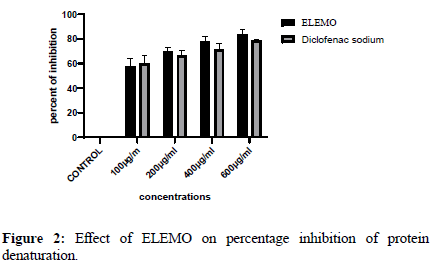
Figure 2: Effect of ELEMO on percentage inhibition of protein denaturation.
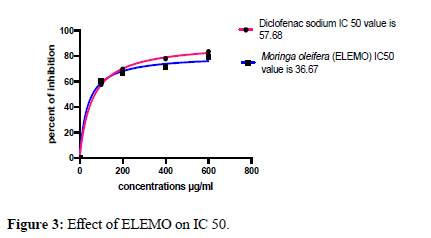
Figure 3: Effect of ELEMO on IC 50.
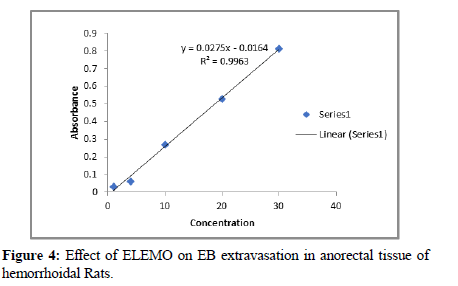
Figure 4: Effect of ELEMO on EB extravasation in anorectal tissue of hemorrhoidal Rats.
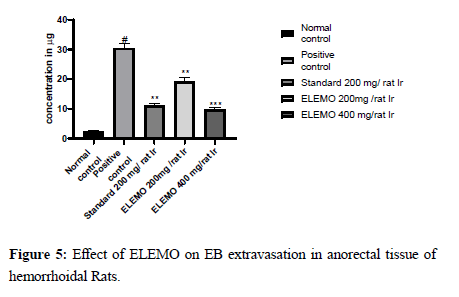
Figure 5: Effect of ELEMO on EB extravasation in anorectal tissue of hemorrhoidal Rats.
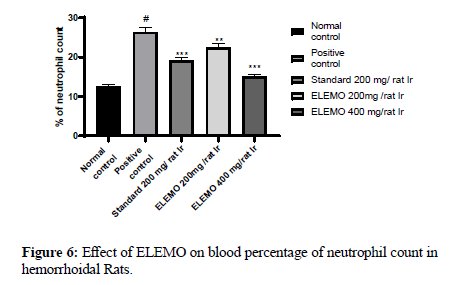
Figure 6: Effect of ELEMO on blood percentage of neutrophil count in hemorrhoidal Rats.
Recto anal Coefficient (RAC) is defined as the weight of the rectal tissue by body weight [16].
Recto Anal coefficient=weight of rectal tissue (mg)/Body weight (g)
Croton oil preparation, in experimental animals found to induce extravsation in study animals can cause rectal inflammation. Hence, in the current research RAC was determined to measure the intensity of rectal inflammation developed in study animals. Significant, larger RAC values, were reported in positive control group animals (1.47 ± 0.084) when compared to normal group animals (0.85 ± 0.12) indicate development of rectal inflammation by croton oil in these group animals. Whereas, lowered RAC values (1.07 ± 0.080) reported in pilex treated group indicate the protective role of standard against croton oil induce inflammation. Expected positive results were given by plant extract in both low dose 200 mg/kg/ir (1.32 ± 0.048) and high dose (1.08 ± 0.070), compared to group II animals, where a significant lowered RAC values were reported in ELEMO treated albino rats. The effect is found to be more efficacious with high dose as depicted in Figure 7.
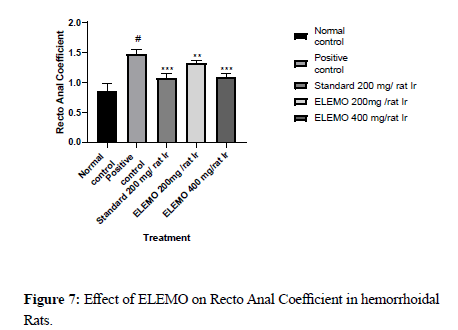
Figure 7: Effect of ELEMO on Recto Anal Coefficient in hemorrhoidal Rats.
Effect of ELEMO on serum inflammatory cytokines TNF-α: Serum separated from the blood samples of study animals was analysed for TNF-α by using GENLISA rat TNF-α enzyme kit. ELISA 90 micro well plate reader was used to estimate pro-inflammatory cytokine TNF-α. On observation of study results it was confirmed croton oil greatly induce pro-inflammatory cytokines, TNF-α in serum of positive control animals (240.00 ± 4.07) compared to normal group-I animals (34.33 ± 3.18). Standard drug containing various chemical components at dose 200 mg/ kg/ir (113.83 ± 5.11) had produced significant inhibitory effect on serum TNF-α in group III animals. A significant inhibition (158.83 ± 5.63) of TNF-α was also reported in serum of rats treated with ELEMO at dose of 200 mg/kg/ ir. Inhibitory effect of Moringa oleifera (128.33 ± 3.45) on serum TNF-α was also observed in group V animals treated with high dose of plant extract 400 mg/kg/ir. This effect further confirms the protective role of ELEMO over inflammatory cytokines in croton oil induced hemorrhoidal rats (Figure 8).
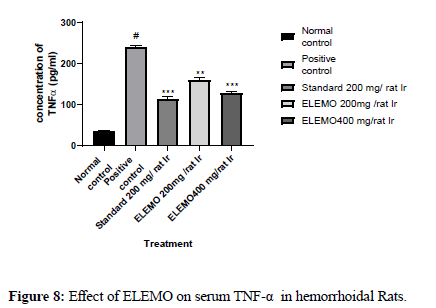
Figure 8: Effect of ELEMO on serum TNF-α in hemorrhoidal Rats.
Effect of ELEMO on serum concentration of interleukin- 6 (IL-6): The current research also includes evaluation of the other pro-inflammatory cytokine, interleukin-6 (IL-6) in the serum of albino rats. Serum IL-6 levels are estimated by using rat GENLISA IL-6 enzyme kit. On analysis of rat serum samples on the last day, different levels of IL-6 were noticed in various groups of study animals. It was found that the animals treated with normal saline had no effect on IL-6 levels (70.50 ± 3.1). Rise in serum IL-6 levels (121.00 ± 3.7) of positive control animals may be due to croton oil preparation. When compared with positive control animals, a significant protection (103.00 ± 2.0) is given by plant extract in group IV animals against the croton oil induced rise of serum IL-6 levels. The inhibitory role of ELEMO over IL-6 levels was also observed in group V animals with reduced IL-6 levels (98.00 ± 1.8) compared to group IV low dose treated and Group II positive control albino rats. High dose of ELEMO 400 mg/kg/ir in the study seems to offer more protection over inflammatory cytokines compared to low dose of ELEMO 200 mg/ kg/ir. Standard drug at dose 200 mg/kg/ir had expressed expected results significantly inhibited serum IL-6 levels (95.00 ± 1.8) compared to positive control rats (Figure 9).
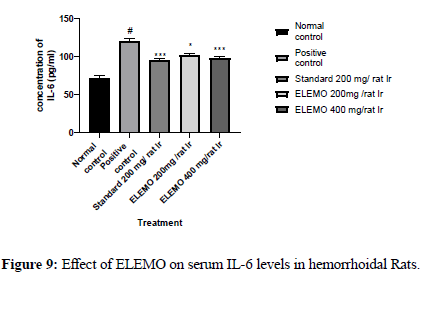
Figure 9: Effect of ELEMO on serum IL-6 levels in hemorrhoidal Rats.
Effect of ELEMO on serum concentration of interleukin- 6 (IL-6):
The study was focused to evaluate the effect of ELEMO on croton oil induced, inflammatory mediated hemorrhoid constipation. For this the daily average stool weight of rats was observed. In this study it was noticed that the daily average stool weight (9.67 ± 0.428) in positive control animals is significantly reduced compared to normal group animals (21.80 ± 1.04). Moreover, stools formed by these animals do not have a proper shape. Croton oil preparation seems to produce a constipation like effect in study animals. While the treatment of animals with ELEMO 200 mg/kg/ir in the group IV animals has given better results, there is a significant improvement in daily average stool weight (14.50 ± 0.953) of these animals compared to positive control animals. ELEMO at dose 400 mg/kg/ir in group V animals was found to inhibit croton oil induced constipation effect with more increase in daily average stool weight (17.30 ± 0.695) compare to standard (16.10 ± 0.645) and positive control group (9.67 ± 0.428). Nearly a normal like effect is reported with high dose of plant extract (Figure 10).
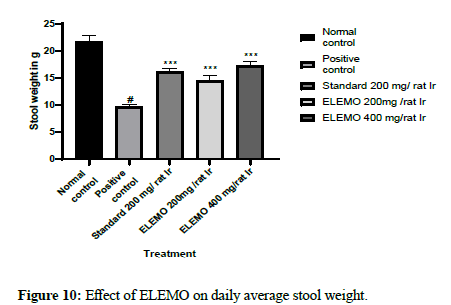
Figure 10: Effect of ELEMO on daily average stool weight.
Histopathological studies
This section of the study contains histopathological studies carried out on recto-anal tissues of second set of 30 albino rats. These studies are done to know the effect of ELEMO on histological changes induced by croton oil preparation in recto-anal tissues. Histological study reports of normal control group I showed normal histology with proper cell alignment and architecture as represented in Figure 11. Whereas, croton oil preparation in group II positive control animals found to induce significant changes like haemorrhage, mucosal tissue damage, blood vessel dilation, and necrosis with poor healing. Treatment with standard drug found to exhibit nearly a normal recto-anal histology. Rectal tissues of animals treated with ELEMO at dose 200 mg/ kg/ir on the other hand showed mild changes, tissue damage followed by healing is seen, no hemorrhage is observed, intact mucosal linings are found, and deposition of inflammatory cell noticed. ELEMO at dose 400 mg.kg/ir had found to exert better protective role compared to group III and Group II animals. Very mild changes are reported, tissue healing is seen, infiltration of cells are minimal, necrotic changes seen are found to be moderate Figure 11. Effect of ELEMO on anorectal tissue of rats in croton oil preparartion induced hemorrhoidal rats. (A) Rectal tissue rats represent normal cell arrangement in normal group rats; (b) severe inflammation, Rectal mucosal changes and cell infiltration shown in positive control group rat rectal tissue (c) Nearly normal rectal tissue and cellular architecture of seen in standard drug 200 mg/kg/ir treated animals. (d) Mild to moderate inflammation, hemorrhage, necrosis appeared in rats treated with T. procumbens 200 mg/kg/ir (e) Inflammation, haemorrhage, necrosis, blood vessel dilation is minimal in rat rectal tissue treated with 400 mg/kg/ ir of Moringa oleifera.
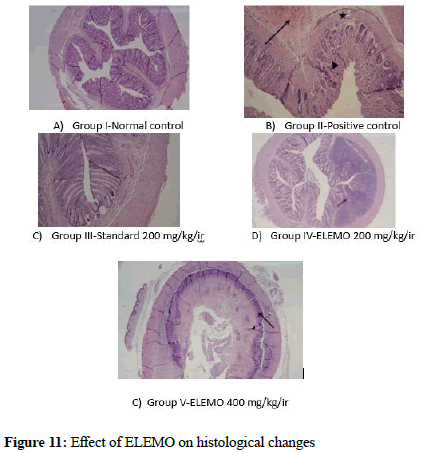
Figure 11: Effect of ELEMO on histological changes
Discussion
Hemrrohoids are also known as piles, they are found as vascular cushions in the anal canal. They were found to develop at right anterior, right posterior, and left lateral positions of anus [21]. The disease was linked with the engorgement and dilation of rectal blood vessels [22]. The disease is mostly commonly encountered by gastro intestinal surgeons, general physicians in their daily practice in India [23]. Constipation, pregnancy, continuously elevated venous pressure in the hemorrhoid plexus of rectum, age, and low fibre diet are some are the predisposing factors of the disease [24]. Most of the surgical and nonsurgical procedures currently available for treatment suffer from disadvantage like recurrence, pain etc. Hence, the authors have selected a natural agent, plant based drugs, Moringa oleifera for the treatment of hemorrhoids. Though the pathogenesis of the disease is multifactorial, inflammation is the main mechanism responsible for the damage of the connective around the anus and the mechanism is also responsible ischemia, thrombosis, and ulceration of hemorrhoidal tissue [25]. Hence, ethanolic leaf extract of Moringa oleifera was evaluated for its anti-inflammatory mediated anti-hemorrhoidal activity. The preliminary phytochemical studies conducted on the ethanolic leaf extract of Moringa oleifera revealed the presence of various phytoconstituents like alkaloids, amino acids, glycosides, phenols, and flavanoids etc.
Protein denaturation is the major mechanism present behind the inflammation [26]. The authors in this view have conducted the in-vitro study, to identify the initial protective role of plant extract over inflammatory proteins. Study results showed that plant extract at different concentrations was found to inhibit the protein (egg albumin) denaturation. A dose dependent type of protein denaturation inhibitory property was shown by Moringa oleifera. The obtained in-vitro study results are found to be satisfactory hence, in-vivo study was planned to evaluate the anti-inflammatory mediated anti hemorrhoidal property of plant extract in croton induced hemorrhoidal rats. Henorrhoids were induced in experimental rats by applying croton oil preparation intra rectally into various groups of the study rats. Croton oil preparation found to induced hemorrhoids in the study animals by activating inflammatory pathways extravasations followed by rise of inflammatory mediators like neutrophils, cytokines like TNFα, and IL-6 etc [25]. Recto anal coefficient was calculated to measure rectal inflammation induced in study animal by croton oil preparation. Evans blue dye (EB) 30 mg/kg was given through the tail of the rats 30 minutes before the induction of hemorrhoids helps to determine the croton oil induced extravsation in albino rats. Croton oil induced extravasation is clearly reflected in study, where a significant rise in extravsation was observed in positive control animals Group-I compared to normal group animals Group-I. Whereas animals treated with low dose 200 mg/kg/ir and high dose 400 mg/kg/ir of ELEMO there observed significant reduction of EB dye extravasation compared to positive control rats. It may be the protein denaturation inhibitory property of plant extract revealed in in-vitro study might be responsible the reduction in extravasation in plant extract treated animals. Croton oil found to induce rectal inflammation by elevating rectal anal coefficient in group II positive control. Larger RAC values are reported in this group animals compared to normal group animals. Report of significant lower RAC values, in Group-IV animals treated with low dose 200 mg/kg/ir and further better reduction in Group-V animals treated with high dose of ELEMO 400 mg/kg/ir represents positive nature of plant extract in controlling rectal inflammation followed by development of hemorrhoids. Blood samples collected on the last day, of the study, showed a significant rise in neutrophil count in positive control animals compared to Group-I normal animals. It may the chemical constituents of croton oil responsible for such rise of neutrophils in positive control animals. Treatment with 200 mg/kg/ir in Group IV animals and 400 mg/kg/ir in Group V animals, plant extract has offered a significant reduction of neutrophil count compared to positive control group II rats. The expected reason for this may the significant reduction of extravasation by plant extract and its reported phytoconstituents which can inhibit neutrophil degranulation. Study carried out in evaluating proinflammatory cytokines revealed, that there is a significant rise in serum TNF α, and IL-6 reported in positive control group rats compared to normal group rats. It may be the reported chemical constituent 12-O-tetradecanoylphorbol- 13-acetate in croton oil which can stimulate protein kinase C responsible for rise of TNF α, and IL-6. ELEMO in the study has offered significant protection over croton oil induced rise of serum cytokines in Group IV albino rats treated with low dose of plant extract 200 mg/kg/ir. The inhibitory effect over cytokines was further proved in the study where a better and significant reduction in serum TNF α, and IL-6 levels were reported in Group-V animals compared to Group-IV and Group-II animals. Control over inflammatory pathway, extravasation, reduction of neutrophil count by plant extract can be taken as possible mechanism for reduction of cytokines by ELEMO. Early reports showed presence of flavanoids in plant extract [9]. It may be responsible for beneficial reduction of proinflammatory cytokines. The literature also found to support the mentioned mechanism where flavanoids are mentioned for treatment of hemorrhoids [27]. They were also reported to prevent neutrophil degranulation and found to reduce the release of proinflammatory cytokines. Histopathological studies carried out on rectal tissues of second set of albino rats, it was identified that several inflammatory mediated hemorrhoid markers are induced by croton oil preparation in positive control animals. Croton oil in positive control animals group II found to induce severe damage in rectoanal tissues. There observed hemorrhage, necrosis, infiltration of inflammatory cell, and altered rectal tissue architecture. Normal rectal tissue are reported in group I animals with intact mucosal lining and cell alignment. Rectoanal tissues of rats treated with low dose of ELEMO 200 mg/kg/ir in group IV animals represent, moderate changes such as hemorrhage, infiltration of inflammatory cells, with damage followed by tissue healing. While animals treated with high dose of ELEMO 400 mg/kg/ir showed minimal changes with good tissue healing.
Conclusion
The results of the present research carried out, on ethanolic leaf extract of Moringa oleifera showed that plant extract has a potential role in inhibiting pro-inflammatory cytokines TNF-α IL6, in croton oil induced hemorrhoidal rats. Plant extract in the research significantly reduced extravasation and recto anal coefficient in study animals, also exhibited minimal histopatholigical changes in the rectal tissues of rats. Hence, after observing these results we have drawn a conclusion that plant extract can be included as a potential anti-inflammatory mediated anti-hemorrhoidal agent for the treatment of hemorrhoids.
Acknowledgements
The authors express their sincere thanks to management and principal of A.K.R.G. College of pharmacy India.
Conflicts of Interest
We hereby declare that authors have no conflict of interest.
References
- G. Bharat, A. Hemorrhoids, Common ailment among causes and treatment, J Pharm and Pharm Sci Int, 3(2011), 5-12.
[Crossref] [Google Scholar] [PubMed] [Research Gate]
- P. Sheikh, C. Régnier, F. Goron, G. Salmat, The prevalence, characteristics and treatment of hemorrhoidal disease: Results of an international web-based survey, J Comp Effec Res, 9(2020), 1219–1232.
- Z. Sun, J. Migaly, Review of hemorrhoid disease: Presentation and management, Clin Colon Rectal Surg, 29(2016), 22–29.
- S. Riss, F.A. Weiser, K. Schwameis, T. Riss, G. Steiner, The prevalence of hemorrhoids in adults, Int J Colorect Dis, 27(2012), 215-220.
- S. Asif Ali, M. F. Rahman Shoeb, Study of risk factors and clinical features of hemorrhoids, Int Surg Jrnl, 4(2017), 1936 - 1939.
- C. Walter S. Junior, C. D. Almeida Obregon, A. Henrique, L. F. Sobrado, A new classification for hemorrhoidal disease: The creation of the bprst staging and its application in clinical practice, Ann Coloproctol, 36(2020), 249-255.
- V. Lohsiriwat, Hemorrhoids: From basic pathophysiology to clinical management,World J Gastr, 18(2012), 2009-2017.
- C. Sanchez, T. Bertram, D. Chinn, Hemorrhoids, Clinics in colon and rectal surgery, 24(2011), 1-9.
- P. B. Kumar, J. Hemant kumar, J. Dhongade, Phytochemistry and pharmacology of Moringa oleifera lam, J Pharma Copuncture, 23(2017), 194-200.
- M. Anugrahwati, T. Purwaningsih, T. Rustina, J. A. Manggalarini, J. A. Alnavis, Extraction of ethanolic extract of red betel leaves and its cytotoxicity test on hela cells, Procedia Engg, 148(2016), 1402–1407.
- J. R. Shaikh, M. Pati, Qualitative tests for preliminary phytochemical screening: An overview, J Chem Stud Intrn, 8(2020), 603–608.
- J.T. Nicholas, L.L. karen, L.B. Charles, A gap in our understanding: Chronic constipation and its comorbid conditions, Clin Gastro and Hep, 7(2009), 9–19.
- P.A. Haas, T.A. Fox, G.P. Haas, The pathogenesis of Hemorrhoids, Dis Colon Rect, 27(1984), 442–450.
- S. Dharmadeva, L. Galgamuwa, C. Prasadinie, N. Kumarasinghe, In -Vitro anti-inflammatory activity of ficus racemosa l. bark using albumin denaturation method, J Res in Ayur Intern, 39(2018), 239-242.
- M. Azeemuddin, G.L. Viswanatha, M. Rafiq, A.H. Thippeswamy, M.R. Baig, et al., An improved experimental model of hemorrhoids in rats,evaluation of antihemorrhoidal activity of an herbal formulation, ISRN Pharma, 14(2014), 1–7.
- S. Faujdar, B. Sati, S. Sharma, A.K. Pathak, Evaluation and anti-hemorrhoidal activity of bark of acacia ferruginea DC, J Trad Chin Med Scien, 9(2018), 85-89.
- K. Nishiki, K. Nishinaga, D.Kudoh, K. Iwai, Croton oil-induced hemorrhoid model in rat: Comparison of anti-inflammatory activity of diflucortolone valerate with other glucocorticoids, Foli Pharm Jap, 92(1988), 215-225.
- S.R. Dhaswadikar, K.M. Parmar, S.K. Kamble, I. Kathuria, M. Dhobi, Anti-Hemorrhoidal Potential of Standardized Leaf Extract of Dolichandrone Falcata, Phyt Med Plus, 2(2022).
- A. krzyzanowska, Y. Martin, C. Avendario, M.J. Piedras, Evaluation of evans blue extravasation as a measure of peripheral inflammation, Protocol Exchange, 5(2010), 1–8.
- O. Said, Y. Khamaysi, A. Kmail, O. Sadiq, B. Saied, et al., Anti-Inflammatory, antimicrobial, and vasoconstriction activities of an anti-hemorrhoidal mixture of alchemilla vulgaris, conyza bonariensis, and nigella sativa: In Vitro and Clinical Evaluations, J Immuno, 2 (2022) 132-150.
- A. Acheson, J. H. Scholefield, Management of hemorrhoids, BMJ, 336(2008), 380-383.
- W. H. Thomson, The nature and cause of haemorrhoids, Proc R Soc Med,68(1975), 574-575.
- N. Agarwal, K. Singh, P. Sheikh, K. Mittal, V. Mathai, Executive summary - The association of colon and rectal surgeons of india (acrsi) practice guidelines for the management of haemorrhoids—2016, Ind J Surg, 792017), 58-61.
- M. Chiaretti, D. Alunni, G. Pappalardo, M. Dello, S. Venti, Comparison of centella with flavonoids for treatment of symptoms in hemorrhoidal disease and after surgical intervention: A randomized clinical trial, Sci Rprts, 5(2019), 1-14.
- A. Porwal, G.C. Kundu, G. Bhagwat, R. Butti, Polyherbal formulation Anoac‑H suppresses the expression of RANTES and VEGF for the management of bleeding hemorrhoids and fistula, Mol Med Rep, 4(2021), 736.
- S. Banerjee, A. Chanda, A. Adhikari, A. Das, S. Biswas, Evaluation of phytochemical screening and anti-inflammatory activity of leaves and stem of Mikania scandens (L.), Wild, Anls of Med Hlth Sci Res, 4(2014), 532-536.
- T. Mott, A Latimer, K. Edwards, Hemorrhoids: Diagnosis and Treatment Options, Amcn Fam Phys, 3(2018), 172–179.
Copyright: © 2022 Sai Krishna Nallajerla, et al. This is an open access article distributed under the terms of the Creative Commons Attribution License, which permits unrestricted use, distribution, and reproduction in any medium, provided the original work is properly cited.


